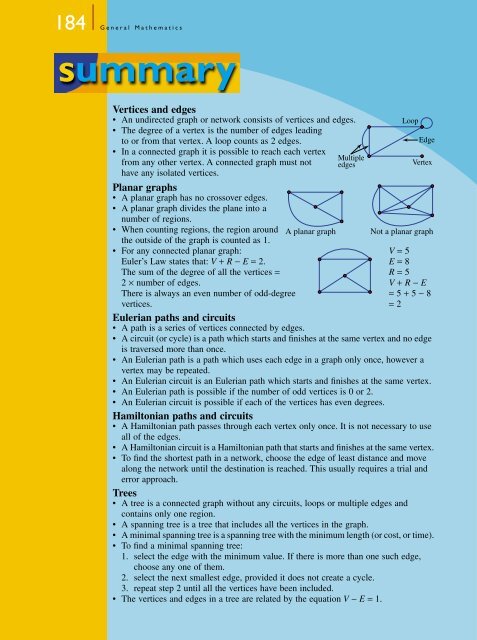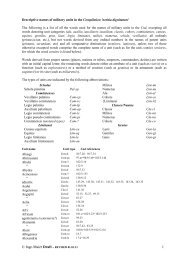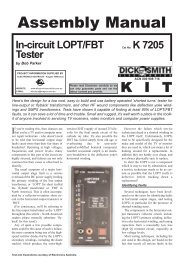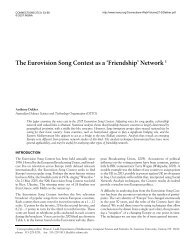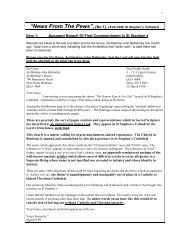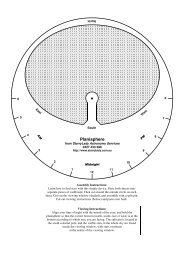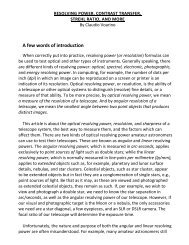Undirected graphs and networks
Undirected graphs and networks
Undirected graphs and networks
You also want an ePaper? Increase the reach of your titles
YUMPU automatically turns print PDFs into web optimized ePapers that Google loves.
184 General Mathematics<br />
summary<br />
Vertices <strong>and</strong> edges<br />
• An undirected graph or network consists of vertices <strong>and</strong> edges.<br />
• The degree of a vertex is the number of edges leading<br />
to or from that vertex. A loop counts as 2 edges.<br />
• In a connected graph it is possible to reach each vertex<br />
from any other vertex. A connected graph must not<br />
have any isolated vertices.<br />
Planar <strong>graphs</strong><br />
• A planar graph has no crossover edges.<br />
• A planar graph divides the plane into a<br />
Multiple<br />
edges<br />
number of regions.<br />
• When counting regions, the region around A planar graph<br />
the outside of the graph is counted as 1.<br />
Not a planar graph<br />
• For any connected planar graph: V = 5<br />
Euler’s Law states that: V + R − E = 2. E = 8<br />
The sum of the degree of all the vertices = R = 5<br />
2 × number of edges. V + R − E<br />
There is always an even number of odd-degree = 5 + 5 − 8<br />
vertices.<br />
Eulerian paths <strong>and</strong> circuits<br />
• A path is a series of vertices connected by edges.<br />
= 2<br />
• A circuit (or cycle) is a path which starts <strong>and</strong> finishes at the same vertex <strong>and</strong> no edge<br />
is traversed more than once.<br />
• An Eulerian path is a path which uses each edge in a graph only once, however a<br />
vertex may be repeated.<br />
• An Eulerian circuit is an Eulerian path which starts <strong>and</strong> finishes at the same vertex.<br />
• An Eulerian path is possible if the number of odd vertices is 0 or 2.<br />
• An Eulerian circuit is possible if each of the vertices has even degrees.<br />
Hamiltonian paths <strong>and</strong> circuits<br />
• A Hamiltonian path passes through each vertex only once. It is not necessary to use<br />
all of the edges.<br />
• A Hamiltonian circuit is a Hamiltonian path that starts <strong>and</strong> finishes at the same vertex.<br />
• To find the shortest path in a network, choose the edge of least distance <strong>and</strong> move<br />
along the network until the destination is reached. This usually requires a trial <strong>and</strong><br />
error approach.<br />
Trees<br />
• A tree is a connected graph without any circuits, loops or multiple edges <strong>and</strong><br />
contains only one region.<br />
• A spanning tree is a tree that includes all the vertices in the graph.<br />
• A minimal spanning tree is a spanning tree with the minimum length (or cost, or time).<br />
• To find a minimal spanning tree:<br />
1. select the edge with the minimum value. If there is more than one such edge,<br />
choose any one of them.<br />
2. select the next smallest edge, provided it does not create a cycle.<br />
3. repeat step 2 until all the vertices have been included.<br />
• The vertices <strong>and</strong> edges in a tree are related by the equation V − E = 1.<br />
Loop<br />
Edge<br />
Vertex


